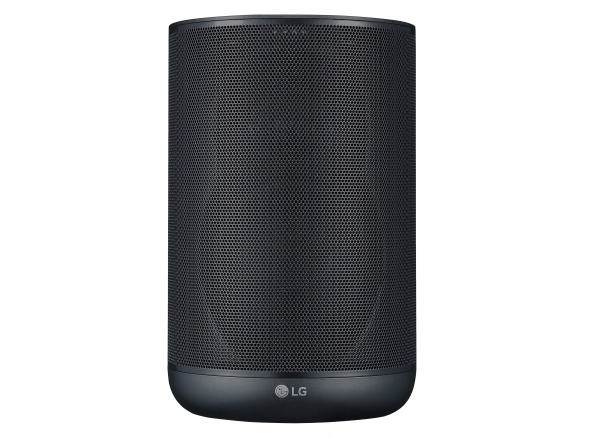Sound QualityThe LG ThinQ WK7 has fair overall sound quality. Bass has good impact and goes fairly deep but is somewhat boomy and prominent. Midrange is somewhat muffled and a bit grainy. Treble is subdued and upper treble is muted. Doesn't do a good job of recovering room ambience and is somewhat congested. No significant difference between WiFi and Bluetooth sound quality. Provide adequate listening volume for a small to medium sized room.
Versatility
Versatility is good. It's a mono speaker, with multi-room support but lacks stereo pairing support with another Lg ThinQ WK7. Wireless: WiFi supports dual-band and this unit has Bluetooth and can output to another speaker but lacks speakerphone functionality. Communications: Lacks support for calling, texting and messaging. Digital Assistant Muting: Has a dedicated switch to disable the digital assistant by muting its microphones. Audio Connections: Lacks analog audio input and outputs. Audio Tailoring: Lacks user adjustable treble and bass controls. OS Support: Android and iOS. Other connections and features: Lacks a USB device port. Streaming by voice command: Supports voice command of many common streaming services such as Google-Play Music, Pandora, Spotify, Tune-In, iHeart Radio. Voice ID: Supports voice identity - a feature which allows the account holder with their "voice print" to access personal information.
Ease of Use
Overall ease of use of the JBL ThinQ WK7 is very good. Wireless setup: Requires an app downloaded to a mobile device, it's easy and intuitive - needs instructions which are included in app, may or may not involve inputting WiFi network password, and account setup. Bluetooth: Provided instructions require the press of the function button to get into Bluetooth mode, or Can be initiated in app device settings but least intuitive, or Verbal command works best "Ok Google start Bluetooth pairing" verbal instructions. Console controls: Lacks volume control label or symbol but some other markings suggest (+/-) that it is a volume control and has a non-persistent graphical position marking. Volume may also be controlled via a natural language command which has an index "marking" via verbal command and acknowledgement. Audio mute: Well marked, prominent, and has a non-persistant indication on unit when muting is engaged. Microphone mute: Well marked, not well placed behind the unit with clear indication when it is engaged. Source selections: Requires app to be installed, app installation is straight forward. Once app is installed switching between inputs requires selecting the "cast" icon in a 3rd party supported app. Fairly intuitive but subject to 3rd Party implementation of cast selection. App remote: Volume control not obvious due to extremely poor placement - only available when content is playing; however, it is repeatable with clear graphic and index of setting. Mute: The marking is not the most obvious, although there is a clear indication when it is engaged. Voice transport controls: Natural language control of transport (Play/Pause/Skip/Mute), volume controls and source selection was easy and intuitive except where noted for the mute function.






















